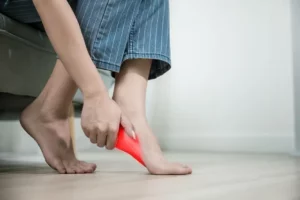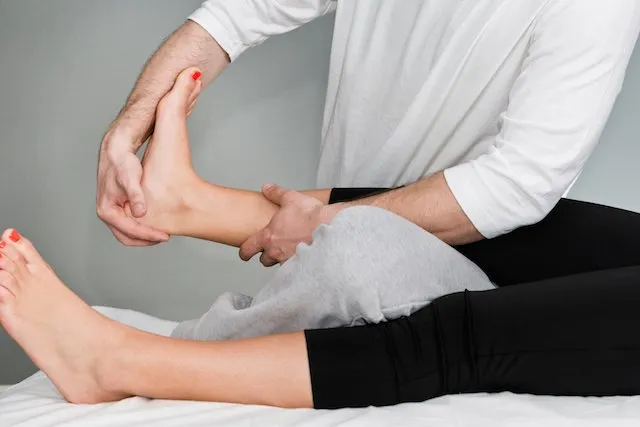The ankle, despite its relatively small size, plays an instrumental role in our mobility. Every step, jump, or sudden dash hinges on its health and functionality. Whether you’ve recently sprained your ankle, are recovering from surgery, or are simply looking to strengthen and understand this critical joint, physical therapy can be the beacon guiding you back to full functionality. In this blog, we delve deep into the world of ankle physical therapy, offering insights, exercises, and tips to aid your recovery and bolster your strength.
Contents
When Should I Seek Ankle Physical Therapy?
 Seeking ankle physical therapy is crucial not only after obvious injuries but also when you notice subtle signs of dysfunction. Here are some situations and symptoms indicating that it might be time to consult a physical therapist for your ankle:
Seeking ankle physical therapy is crucial not only after obvious injuries but also when you notice subtle signs of dysfunction. Here are some situations and symptoms indicating that it might be time to consult a physical therapist for your ankle:
- After an Injury
This includes sprains, fractures, strains, or any traumatic event affecting the ankle. Early intervention can speed up recovery and prevent complications.
- Persistent Pain or Swelling
If you’re experiencing pain that doesn’t improve after a few days of rest, ice, compression, and elevation, or if the swelling remains consistent. Then, it’s time to seek professional advice.
- Limited Mobility
If you notice stiffness, or difficulty moving your foot in all its natural directions, or if you can’t bear weight on it, a therapist can provide exercises and treatments to regain mobility.
- Post-Surgical Rehabilitation
After undergoing ankle surgery, physical therapy is usually recommended to restore strength, and flexibility, and ensure proper healing.
- Recurrent Ankle Sprains
If you’ve had multiple sprains or feel that your ankle “gives out” frequently, it could be a sign of chronic ankle instability. Physical therapy can address this by strengthening the muscles around the ankle and improving proprioception.
- Difficulty with Daily Activities
If common tasks like climbing stairs, walking, or standing become challenging or painful, it might be time to consult a therapist.
Listening to your body is essential. If something feels off, even without an overt injury, it’s always a good idea to seek professional advice. Ankle physical therapy can address minor issues before they develop into more significant problems, promoting long-term ankle health and overall well-being.
How Ankle Physical Therapy Is Helpful?
Ankle injuries, whether minor sprains or post-surgical complications, can severely limit an individual’s mobility and quality of life. But with the help of physical therapy, many find a path to a faster, safer, and more efficient recovery. Here’s a detailed look into how ankle physical therapy is beneficial:
- Pain Management
Physical therapists employ a range of techniques, from massage to ultrasound and electrical stimulation, to alleviate pain. These modalities provide relief. And, also reduce the need for pain medications, minimizing the risks associated with their prolonged use.
- Reducing Swelling
After an ankle injury, swelling is a common occurrence. Therapeutic exercises and techniques help in controlling and reducing inflammation. This, in turn, facilitates healing and improves movement.
- Restoring Range of Motion
Injuries can lead to stiffness and a limited range of motion in the ankle. Through a series of stretches and mobility exercises, physical therapy helps restore this range, allowing for more natural movement.
- Improving Balance and Proprioception
One’s sense of position (proprioception) can be compromised after an injury. Therapists use balance exercises to train the body and mind, reducing the risk of re-injury. And helping the individual regain confidence in their movements.
- Gait Training
Ankle injuries can affect the way an individual walks. Physical therapy aids in re-establishing a normal walking pattern. It will ensure that other joints like the knees or hips aren’t adversely affected due to altered gait.
- Education and Prevention
A key component of physical therapy is patient education. Understanding the mechanics of injuries, proper footwear, and exercises can be a powerful tool in preventing future occurrences.
- Emotional and Psychological Benefits
Dealing with an injury can be mentally taxing. The consistent progress seen in physical therapy often serves as a morale booster. Plus, the guidance and support from a therapist can be reassuring during the recovery journey.
In essence, ankle physical therapy is a multifaceted approach to recovery. It addresses not just the physical limitations of an injury but also the holistic well-being of the individual. Thus, it will ensure they return to their daily activities with confidence and strength.
What Are The Exercises Involved In Ankle Physical Therapy?
 Ankle physical therapy encompasses a variety of exercises designed to restore function, improve strength, enhance flexibility, and prevent future injuries. Here’s a list of some commonly recommended exercises for ankle rehabilitation:
Ankle physical therapy encompasses a variety of exercises designed to restore function, improve strength, enhance flexibility, and prevent future injuries. Here’s a list of some commonly recommended exercises for ankle rehabilitation:
Range of Motion Exercises
- Ankle Circles: While seated, extend your leg and rotate your ankle clockwise and then counterclockwise. This helps improve mobility.
- Ankle Alphabet: Point your toe and “draw” each letter of the alphabet in the air with your foot, moving only the ankle.
Strengthening Exercises
- Towel Curls: Sit down with your feet flat on a towel. Use your toes to scrunch the towel towards you, then push it away.
Resistance Band Exercises
- Dorsiflexion: With the band around your foot, push your foot forward against the resistance.
- Plantar Flexion: Push your foot down against the resistance of the band.
- Inversion: Turn your foot inward against the band’s resistance.
- Eversion: Turn your foot outward against the resistance.
Balance and Proprioception Exercises
- Single Leg Balance: Stand on one foot. Begin with hands on a counter or wall for support, and progress by removing support and eventually closing your eyes.
- Wobble Board/Bosu Ball Balance: Stand on a wobble board or Bosu ball to challenge and improve your ankle stability.
Stretching Exercises
- Calf Stretch: Facing a wall with hands on it, place one foot behind with a straight knee, and the other foot in front. Push your hips forward until you feel a stretch in the back leg’s calf.
- Achilles Stretch: Similar to the calf stretch but bend the knee of the back leg, targeting the lower part of the calf.
Functional or Plyometric Exercises
- Heel Raises: Stand tall and lift your heels off the ground, coming onto your tiptoes.
- Ankle Hops: Hop forward and backward using only your ankles, keeping the knees straight.
- Lateral Hops: Hop side to side over a line or low object.
Massage and Mobilization Techniques
- Soft Tissue Massage: Use your hands or tools like a foam roller to massage the calf and surrounding tissues, promoting relaxation and blood flow.
- Ankle Mobilizations: Gentle manual techniques performed by therapists to improve joint mobility.
- Joint Mobilization: Physical therapists may use hands-on techniques to gently mobilize the ankle joint, increasing its range and decreasing pain.
Overall, it’s essential to consult with a physical therapist before starting these exercises, especially after an injury. The therapist will recommend the most suitable exercises for your condition and ensure you’re performing them correctly. And, with any exercise regimen, it’s crucial to warm up adequately, be attentive to form, and listen to your body to avoid further injury.
How Can I Do Ankle Physiotherapy At Home?
 Undertaking ankle physiotherapy at home can be an effective way to rehabilitate minor injuries, maintain strength, and enhance flexibility. However, it’s essential to consult with a physical therapist before starting any exercise regimen. This will help to ensure that you’re following an appropriate program for your condition.
Undertaking ankle physiotherapy at home can be an effective way to rehabilitate minor injuries, maintain strength, and enhance flexibility. However, it’s essential to consult with a physical therapist before starting any exercise regimen. This will help to ensure that you’re following an appropriate program for your condition.
Here’s a basic guide to help you perform ankle physiotherapy exercises at home:
1. Setup
- Flat, non-slippery surface.
- A sturdy chair or counter for support.
- Gather essential tools: resistance bands, and a towel.
2. Warm-Up
- 5-10 minutes of walking or stationary biking.
- Gentle ankle movements: rotations, pointing, and flexing.
3. Range of Motion
- Ankle Circles.
- Ankle Alphabet.
4. Strengthening
- Towel Curls: Scrunch and straighten using toes.
- Resistance Band Exercises: Dorsiflexion, Plantar flexion, Inversion, Eversion.
5. Balance
- Single Leg Stand: Progress to eyes closed.
- Heel-Toe Walking.
6. Flexibility
- Calf Stretch against a wall.
- Achilles Stretch with a bent knee.
7. Functional Movements
- Heel Raises.
- Shallow Squats.
8. Cool Down
- Gentle stretches.
- Foam rolling (if available).
9. Guidelines
- Perform 3-5 times a week.
- Document progress: note pain levels and challenges.
- Prioritize safety: Avoid any exercises causing sharp pain.
- Consult with a professional if unsure about an exercise.
Is Physiotherapy Good For Ankles?
 Absolutely, physiotherapy is a highly effective approach for addressing ankle issues. The ankle is a complex joint that bears the weight of the body. This makes it particularly susceptible to injuries, strains, and wear and tear. Physiotherapy offers targeted exercises and interventions that address pain, swelling, and limited range of motion. And, also enhance strength and stability. By understanding the mechanics and intricacies of the ankle, physical therapists design personalized regimens that promote healing, restore function, and prevent future injuries.
Absolutely, physiotherapy is a highly effective approach for addressing ankle issues. The ankle is a complex joint that bears the weight of the body. This makes it particularly susceptible to injuries, strains, and wear and tear. Physiotherapy offers targeted exercises and interventions that address pain, swelling, and limited range of motion. And, also enhance strength and stability. By understanding the mechanics and intricacies of the ankle, physical therapists design personalized regimens that promote healing, restore function, and prevent future injuries.
Moreover, beyond just the physical aspects, physiotherapy plays a vital role in the psychological recovery from ankle injuries. Being immobile or limited in movement can take a mental toll. The structured progression in therapy often instills confidence in individuals, helping them return to their regular activities, sports, or routines with reassurance and resilience. So, this holistic approach ensures that the individual regains optimal ankle health both physically and mentally.
Conclusion
In conclusion, the importance of physiotherapy for ankle health cannot be understated. Ankle injuries, ranging from minor strains to more severe complications, can significantly hinder an individual’s mobility and overall quality of life. Through targeted exercises, personalized interventions, and holistic approaches, physiotherapy provides a pathway to accelerated, safer, and more effective recovery. Not only does it address the physical dimensions of healing, but it also caters to the mental and emotional well-being of the individual.
So, whether you’re recovering from an injury or aiming to prevent one, the value of integrating physiotherapy into your health regimen is undeniable. Thus, physical Therapy helps patients recover from pain. If you’re experiencing Back, Shoulder, Knee, Neck, Elbow, Hip, or Arthritis pain, a physical therapist at PhysioMantra can help: Book an online physical therapy session.



